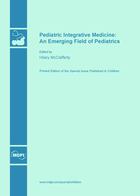Pediatric Integrative Medicine: An Emerging Field of Pediatrics
A special issue of Children (ISSN 2227-9067).
Deadline for manuscript submissions: closed (31 May 2014) | Viewed by 153645
Special Issue Editor
Interests: pain and stress management in the pediatric emergency department; mind–body medicine in children; pediatric integrative medicine; physician wellness; medical education
Special Issues, Collections and Topics in MDPI journals
Special Issue Information
Dear Colleagues,
Pediatric integrative medicine is a specialty that blends conventional medicine with evidence-based complementary therapies. Research shows that use of integrative medicine is common in children, especially in those living with chronic illness. Knowledge in several important areas of pediatric integrative medicine has expanded exponentially over the last decade. Despite this progress, many pediatricians and practitioners who work with children remain unaware of developments in this field.
The goal of this special issue is to: define pediatric integrative medicine in its modern context, provide a history of the field’s evolution, highlight areas where research for its use in children is most robust at this time, and identify areas where research is lacking or evolving. Models of the use of integrative medicine in clinical pediatrics will be examined. Bioethics, informed consent, and provider credentialing will be discussed.
Some of the most exciting clinical applications of integrative medicine in pediatrics include the use of mind-body medicine therapies such as guided imagery, hypnosis, and biofeedback for the treatment of pain. Mitigation of toxic stress and its health manifestations in children are another area of great potential application of the mind-body therapies. Other areas include integrative approaches to chronic illness, such as cancer, asthma, arthritis, bowel disease, and other chronic conditions where conventional therapies are necessary, yet leave treatment gaps that can be filled with evidence-based integrative therapies targeting lifestyle elements such as nutrition, sleep, physical activity, and social support that are often overlooked in this patient population. Integrative approaches have great potential in preventative heath. Conditions such as obesity and the metabolic syndrome affect a sobering number of children across all age ranges. Few successful treatment models exist for this patient population. Healthy lifestyle measures learned early in life can be a critical factor in providing a foundation for lifelong health for the child and family. Successful models for the use of integrative medicine in these patient populations are needed and will be explored.
While some progress in these areas has been made, there is substantial room for further debate and investigation. This special issue in Children will act as a forum to discuss and share knowledge about incompletely understood or controversial areas in the field of pediatric integrative medicine. Both reviews and original research contributions will be considered for publication.
I look forward to receiving your contributions!
Dr. Hilary McClafferty
Guest Editor
Manuscript Submission Information
Manuscripts should be submitted online at www.mdpi.com by registering and logging in to this website. Once you are registered, click here to go to the submission form. Manuscripts can be submitted until the deadline. All submissions that pass pre-check are peer-reviewed. Accepted papers will be published continuously in the journal (as soon as accepted) and will be listed together on the special issue website. Research articles, review articles as well as short communications are invited. For planned papers, a title and short abstract (about 100 words) can be sent to the Editorial Office for announcement on this website.
Submitted manuscripts should not have been published previously, nor be under consideration for publication elsewhere (except conference proceedings papers). All manuscripts are thoroughly refereed through a single-blind peer-review process. A guide for authors and other relevant information for submission of manuscripts is available on the Instructions for Authors page. Children is an international peer-reviewed open access monthly journal published by MDPI.
Please visit the Instructions for Authors page before submitting a manuscript. The Article Processing Charge (APC) for publication in this open access journal is 2400 CHF (Swiss Francs). Submitted papers should be well formatted and use good English. Authors may use MDPI's English editing service prior to publication or during author revisions.







